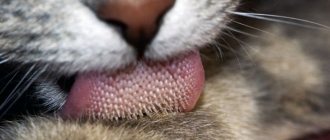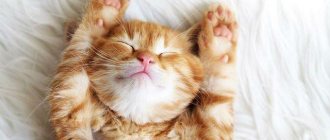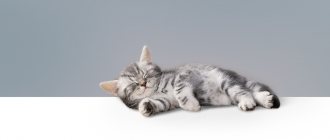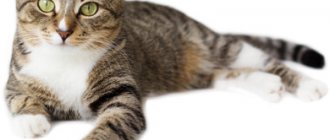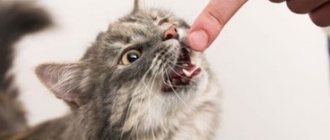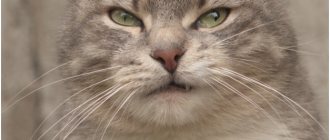Like other higher mammals, cats are endowed with a rich range of emotions, feelings and moods, as well as diverse possibilities for their expression. Since the mental reflection of the objective world has an individual coloring, the general direction of the cat’s experiences depends on the character of the pet. So, a brave and inquisitive cat will be happy to meet new people and study furnishings, while a timid and shy one will prefer to hide. On the other hand, there is a completely standard set of poses and sounds with which cats express their attitude to the situation.
Fear
Fear is one of the most powerful reactions, since it is generated by the instinct of self-preservation and is associated with a powerful hormonal release in the body. This feeling makes one literally turn to stone on the spot, and the whole cat’s face turns out to be the personification of the saying: “Rhinestone has big eyes.”
Externally, fear is expressed:
- increased muscle tone;
- stiffness of movements;
- head pulled into shoulders;
- rounded eyes, widely dilated pupils;
- ears down;
- with its tail between its legs (read the article on how to understand a cat by its tail).
A frightened cat is silent or makes abrupt, muffled sounds.
How cats show emotions
Pets communicate using body language, sounds and smells. By taking certain poses and backing them up with sounds, cats convey some information to their interlocutor. But there are some subtleties here. For example, if a cat wags its tail , one cannot definitely say that it is unhappy.
Depending on the range of motion, body position and other little details, wobbling should be interpreted differently:
- the tail is lowered or positioned horizontally, whips on the sides, the cat is tense, the ears are pressed or strongly pricked, the lips are compressed, it can make threatening sounds - anger, rage, irritation;
- the tail is raised, shaking slightly, the cat is collected, ears are directed forward, eyes are wide open - concentration, interest, participation, basically a positive attitude;
- the tail sways slightly, the movements are smooth, the cat is relaxed, the eyes are closed - the pet is resting, but is ready to switch to another activity;
- the tail is tense, motionless or nervously twitching, very fluffy, the cat is extremely concentrated, the ears are pricked up or laid back - fear, tension, a feeling of danger, severe discomfort.
It is very important to notice the position of the ears . If the “locators” are directed forward, the cat is focused, interested in something, and this is also an indicator of confidence. Ears pinned down – anger, conflict. Ears are laid back, but not pressed down - uncertainty, confusion, some confusion.
The eyes well reflect the state of the four-legged friend. Interest, fear, irritation, joy - all these emotions can be read in a cat’s gaze, especially if the owner has already managed to study the pet’s character. If a cat winks , it means that she is comfortable and she morally supports the owner.
You can also read emotions by paying attention to the expression on your four-legged friend’s face. Pets have developed facial muscles that are involved in demonstrating their mood.
You can try an experiment: catch the cat’s gaze, blink at her and turn away a little. Often, pets are in a hurry to approach after such an address, because this combination of looks and gestures means an invitation in cats.
Sound recognition is easier. Menacing growls, howls and hisses cannot be confused with gentle supportive purrs or demanding meows . Some cat breeds (Oriental, Siamese, Tonkinese, Balinese, etc.) are especially talkative. They can sing songs in different ways around the clock, often disturbing their owner. However, natural sociability plays a role here and you should not punish your pet for being loud.
Anger
Irritability can quickly turn into anger if the animal is not left alone. Increased negative emotions are indicated by:
- tail moving with a large amplitude from side to side;
- ears pressed to the head;
- point-blank gaze;
- front paw raised for protection;
- arching of the back;
- hiss;
- angry guttural sounds similar to howling.
How do cats feel?
In addition to the basic emotions - joy, playfulness, anger, irritability, peace, etc. cats, like people, experience many other more complex sensations. For example, pets clearly sense jokes and barbs directed at them and show dissatisfaction, because no one likes to experience such moral discomfort.
A cat with acute intelligence always understands when it is praised, when it is scolded, and when it becomes the subject of ridicule.
One has only to carefully observe the pet - when it comes to him, the cat immediately pricks up his ears. She tries not to show that she is interested, but in fact she immediately switches to the conversation, trying to understand whether they are speaking well or badly about her, or maybe they will offer something.
Of course, animals do not understand human words, but they respond well to intonation, voice volume, familiar sound combinations (pet name, familiar commands, words often used with a cat, etc.) and quickly react to each situation differently.
Ready for battle
Cats are very cautious animals, so in a dangerous situation they choose to camouflage and wait, or flee.
However, when cornered, they fight back using their natural arsenal of 20 hooked claws and fanged mouths. A cat ready to fight signals its serious intentions:
- deep visual concentration on the opponent;
- ears pressed to the back of the head;
- bared mouth and hissing;
- strikes with the front paw with extended claws;
- tipping over onto your back with half-bent tense legs;
- a drawn-out battle cry;
- lightning jump attack.
Do people react to sadness?
Cats are considered to be great healers. The frequency of a cat's purring is 24 Hz, which is quite enough to balance the energy background of diseased human organs. The fact is that the cat perfectly senses the frequency of vibration from unhealthy cells and tries to align them. That is why cats lie on the sick organs of their owners and sleep with them during illness.
The nature of understanding the owner's deep emotional state is of the same nature. For us, sadness often comes after a severe stressful situation. At this moment, the human body vibrates in a completely different way, which the cat reads well. With a cute purr and a soft massage with his paws, he tries to normalize the energy state of his beloved owner.
Disappointment
Sometimes cats can become bored, resentful and upset. Gray emotions such as disappointment, sadness and despondency are clearly illustrated by “body language”:
- a faded, absent look;
- ears turned to the sides;
- hunched posture;
- reluctance to play and move actively;
- tail down.
An increase in such signs in combination with disturbances in natural functions, loss of appetite and elevated body temperature indicates a serious illness of the animal and requires the intervention of a veterinary specialist.
Scientists have discovered who understands cat emotions
The emotions of cats are difficult to understand, but some people are able to surprisingly accurately interpret the expressions of cat faces, Canadian experts from the University of Guelph have found. They talked about this in an article in Animal Welfare
.
Although cats are no less popular as pets than dogs, they have been studied much less well, the authors of the work write. The entire understanding of cat emotions comes down to such manifestations as hissing, raising fur, pressing ears and other signs of aggression. People cannot determine the emotional state of a cat by its meowing, and cannot understand from its facial expressions whether it is in pain or not. However, research has shown that some people are better at recognizing cat emotions than others, so scientists decided to look into this issue in more detail.
“The ability to read animal expressions is critical to their well-being.
We've found that some people are very good at recognizing cats' emotions. This shows that these skills can be taught to more people,” says Professor Lee Neal, lead author of the study.
Until now, the only research that has looked at emotion in cats' faces has been a study of pain expressions.
“Our study is the first to look at assessing a wider range of negative emotional states in animals, including fear and frustration, as well as positive emotional states,” adds Professor Georgia Mason, co-author.
More than 6,300 people from 85 countries participated in the study. 93% of them had owned cats at some point in their adulthood, and 80% were living at home at the time of the study. They had to watch 20 short online cat videos from a collection of 40 videos collected mostly from YouTube and fill out online questionnaires.
close
100%
Universities Federation for Animal Welfare
“We have proven that the Internet and cats are a powerful combination,
- researchers joke. “YouTube has proven to be a rich source of cat videos, and more than 6,000 participants completed our online survey in just ten days.”
The cats in the video experienced either positive emotional states (such as when they were petted or given treats) or negative emotional states (such as when they were experiencing health problems or were in situations that caused them to retreat or run for their lives). Each video focused on the cat's face. None of the cats showed fearful expressions such as bared fangs or flattened ears, as these features are already widely known.
Participants had to answer whether the cat was experiencing positive emotions, negative emotions, or whether they found it difficult to answer.
For most participants, the test was difficult. The average score was 12 out of 20—slightly above chance.
But 13% of participants showed very good results, scoring 15 points or more. More often they were women and veterinarians. Young people also performed the task better.
“The fact that women performed better overall than men is consistent with previous research that has shown that women are better at reading nonverbal expressions of emotion in both humans and dogs,” says Mason.
However, love for cats in itself did not contribute to obtaining higher scores.
The fact that some people can read a cat's emotions shows that others can be taught to do the same, the researchers note.
“This is important because it can help strengthen the bond between owners and cats and thus improve the care and well-being of cats,” says Neal.
Previously, Russian veterinarians said
about what diseases domestic cats most often suffer from.
It turned out that animals in Moscow suffer most from obesity, urolithiasis, as well as allergies and dermatitis, which are caused by the pet’s poor diet.
The most common infectious diseases were calcivirosis and panleukopenia. Maine Coon, Sphynx and Bengal cats are most often brought to see a veterinarian.
Experts noted that it is important to carefully monitor the diet of any pet, as well as vaccinate the animal in a timely manner.
Playful mood
Kittens play at any age, stretching their muscles and satisfying the “beast in themselves,” but for growing kittens, games are a way to explore the world.
Sometimes cat fun can be too violent, fueled by the hunting instinct and ending with torn curtains or torn upholstery of a new sofa. Wanting to play, the cat takes a typical pose, which is characterized by:
- gaze focused on potential “prey”;
- forward-pointing ears;
- twitching tail tip;
- moving around the apartment in quick leaps;
- sudden attacks from shelters as an element of “hunting” for a broom, a vacuum cleaner brush or the owner’s feet;
- capturing “prey” with all four paws and teeth.
Experts identify 10 main signs of depression:
- apathy, refusal to eat, even treats and activity;
- increased irritability, desire to hide, to be alone;
- sudden mood changes;
- refusal to care for your fur;
- damage to furniture and other items;
- plaintive, causeless meows;
- refusal to go to the toilet in your litter box;
- attempts to mark territory in sterilized cats;
- change in behavior: an affectionate cat suddenly becomes angry and aggressive.
Often, owners do not notice the first signs of depression in their pet. In addition, disturbances in the psycho-emotional state can be caused by hormonal changes or problems in the functioning of internal organs. Therefore, first you need to contact your veterinarian.
Do cats have a sense of humor?
This question is more difficult to answer. Cats may have a sense of humor, but they probably won't find your favorite joke funny. However, when something moves unexpectedly or a toy does something they haven't seen before, cats may seem surprised.
Some cats will even look like they are laughing and try to repeat what amused them.
© shutterstock
It's hard to tell whether this reaction is a manifestation of humor, which is difficult to read and appreciate, or the curiosity that cats have. Chances are, most of the time your cat does something, they are interested in learning more about it, don't quite understand it, or it satisfies some of their instincts.
